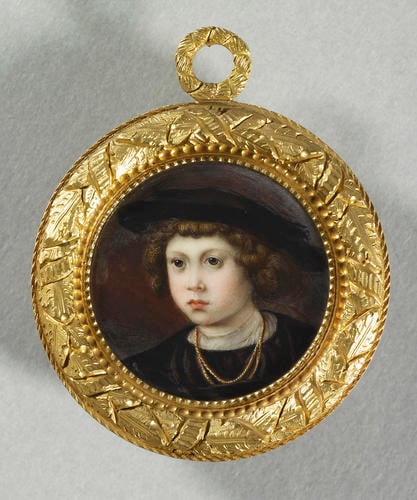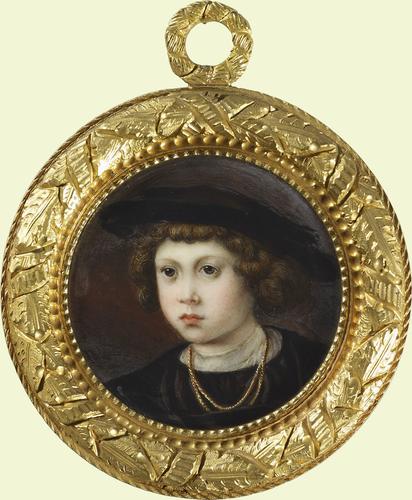-
1 of 253523 objects
John, Prince of Denmark (1518-1532) Signed and dated 1845
Enamel on gold | 3.0 cm (support, diameter) | RCIN 421703
-
William Essex trained as an enamel painter in the workshop of Charles Muss (1779 – 1824), Enamel Painter to William IV. Essex first exhibited at the Royal Academy in 1818 and throughout the 1820s and early 1830s built up a successful practice, working chiefly in enamel. William Essex must have had his first introduction to court circles through Charles Muss. He may initially have worked in collaboration with his teacher, but by 1827 was earning his own commissions from George IV. In 1834 Essex painted an enamel miniature of Charlotte, Duchess of Northumberland, governess to Queen Victoria, after Sir Thomas Lawrence; although he was already well established in royal circles, his patronage by the Duchess of Northumberland may have been an additional factor that contributed to his appointment as Enamel Painter to Queen Victoria in 1837 and Enamel Painter to Prince Albert in 1841. Queen Victoria employed Essex to make numerous enamel copies of portraits of her after Franz Xaver Winterhalter, which were set into bracelets and distributed as gifts. He also made numerous copies of portraits of her relatives and contemporaries. Most of these were commissioned within the same year as the original on which they were based, and were often given by Queen Victoria to Prince Albert. He also made historical copies of early miniatures and portraits at Windsor. Despite Essex's ostensible success, however, he fell into poverty in his later years and was forced to request that the Queen supplement his artist's annuity of £40 with a pension.
Essex's enamel is a copy of the head of John, Prince of Denmark, taken from the central figure in the triple portrait of the children of Christian II of Denmark by Jan Gossaert, called Mabuse, dating from 1526, in the Royal Collection (405782) The young Prince is shown in Mabuse's portrait in mourning for his mother, who had died in January 1526. John (1518 – 32) was the eldest surviving son of Christian II of Denmark and Isabella of Austria.
Signed, dated and inscribed on the counter-enamel in black paint: Arthur, Prince of Wales / Son of Hen. VII / Died 1502. / Painted by W. Essex 1845 / Enl painter to Her Majesty & / H.R.H. Prince Albert after / the Origl. by Mabuse.Provenance
Commissioned by Queen Victoria in 1845
-
Creator(s)
-
Medium and techniques
Enamel on gold
Measurements
3.0 cm (support, diameter)
4.7 x 4.7 cm (frame, external)
Other number(s)
Alternative title(s)
Arthur, Prince of Wales (1486-1502), previously identified as

